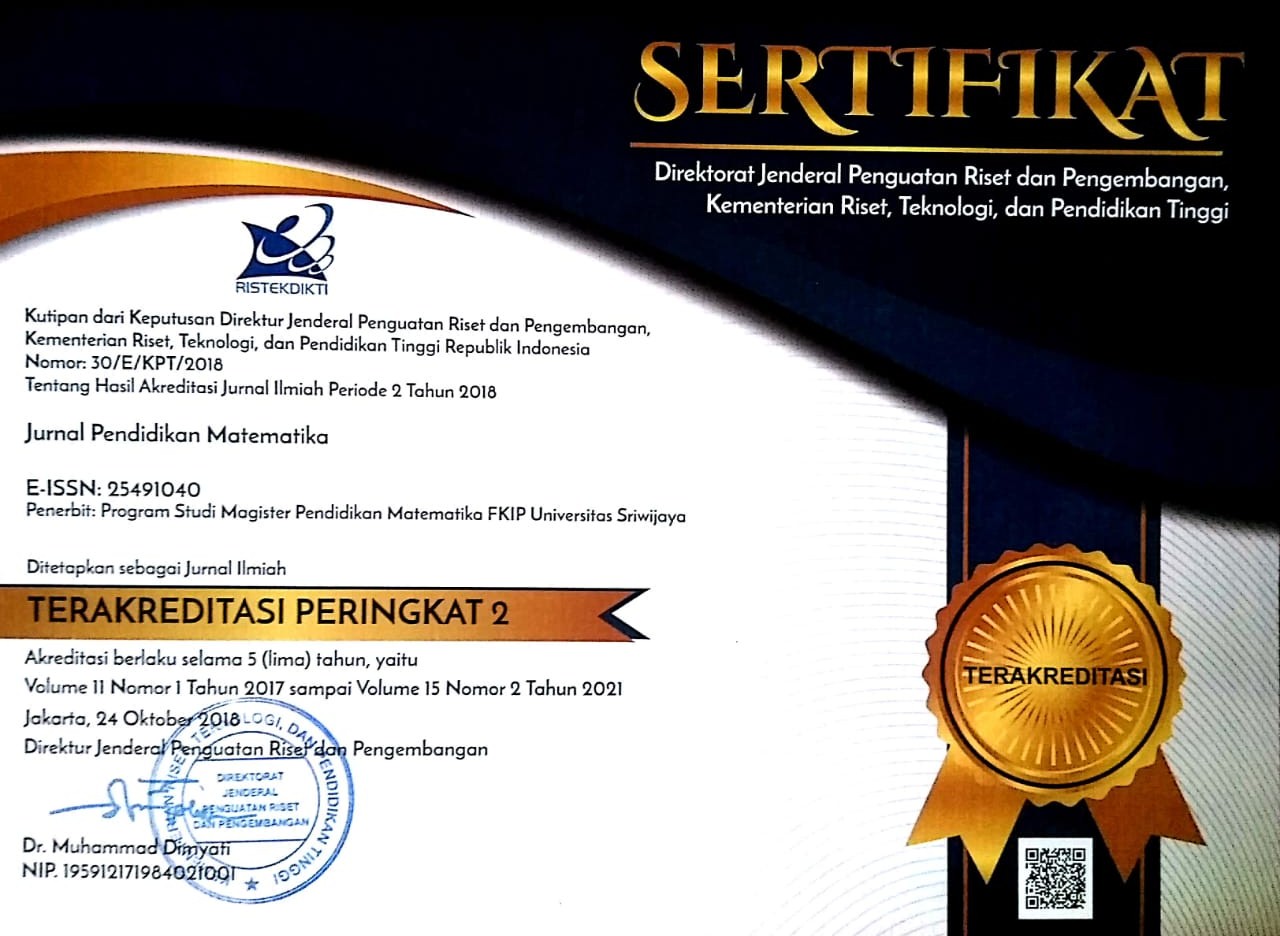Ethnomathematical Study on Indigenous Fish Trap: Example from Kijang, Bintan Regency
Abstract
The continuous exploration of mathematics as a human activity triggers the need to research ethnomathematics. This study aimed to identify ethnomathematics in the manufacture of indigenous fish traps (Bubu) from Bintan Regency. This ethnography study uses direct observation, interviews, and documentation. The researcher acts as the main instrument. The data were analyzed using the Spradley analysis technique, namely domain, taxonomic, componential, and cultural theme analysis. Data reduction, data presentation, and conclusions were carried out for each analysis. The results show that there are mathematical activities in designing, counting, and measuring length dimensions in Bubu's making. In these activities, there are mathematical concepts, including three-dimensional figures, the net of three-dimensional figures, curves, odd numbers, sequences with their attributes, bilateral symmetry, symmetry axes, figurative numbers, the congruence of plane figures, and length measurements with non-standardized units. These results showed that the Bubu maker already had a geometric sense through the symmetrical concept that became the basis for two activities such as counting and measuring, similar to the results of ethnomathematical research on the Yupiaq Eskimo community in Alaska and the Carolina Islanders in Micronesia. This study provides ideas to utilize everyday phenomena in teaching mathematics as a starting point prior to learning mathematics more formally.
Keywords
Full Text:
PDFReferences
Abdullah, A. S. (2017). Ethnomathematics in perspective of Sundanese culture. Journal on Mathematics Education, 8(1), 1–16. https://doi.org/10.22342/jme.8.1.3877.1-15
Aprianti, M., Dewi, D. A., & Furnamasari, Y. F. (2022). Kebudayaan Indonesia di era globalisasi terhadap identitas nasional Indonesia. Edumaspul: Jurnal Pendidikan, 6(1), 996–998. https://doi.org/10.33487/edumaspul.v6i1.2294
Ascher, M., & D’Ambrosio, U. (1994). Ethnomathematics: A dialogue. For the learning of mathematics. JSTOR, 14(2), 36–43. Retrieved from: https://www.jstor.org/stable/40248114
Banurea, J. S., & Tobing, M. W. L. (2019). Kajian produktivitas tangkapan bubu kawat dengan kontruksi perbedaan jumlah funnel untuk nelayan sibolga dengan analisis matematika. Jurnal Penelitian Terapan Perikanan Dan Kelautan, 1(1), 1–8. Retrieved from: https://stpsibolga.ac.id/ojs/index.php/TAPIAN_NAULI
Bestari, P., Marsidin, S., & Sulastri, S. (2023). Strategi konservasi kebudayaan lokal di Pesisir Selatan. Journal on Education, 05(02), 2758–2765. http://dx.doi.org/10.31004/joe.v5i2.920
Constant, J. (2016). The concept of symmetry or self similarity often relates to elements of proportion, harmony and elegance. In G. Darvas (Ed.), Symmetry: Culture and science. Symmetrion.
D’Ambrosio, U. (2007). Ethnomathematics: Perspectives. North American Study Group on Ethnomathematics, 2(1).
D’Ambrosio, Ubiratan. (1999). Literacy matheracy technoracy: A trivium for today. Mathematical Thinking and Learning, 1(2), 131–153. http://dx.doi.org/10.1207/s15327833mtl0102_3
Embong, R., Aziz, N. M. A., Wahab, Z. A., & Maidinsah, H. (2010). An insight into the mathematical thinking of the Malay songket weavers. Procedia - Social and Behavioral Sciences, 8(December 2010), 713–720. https://doi.org/10.1016/j.sbspro.2010.12.099
Fajriyah, E. (2018). Peran etnomatematika terkait konsep matematika dalam mendukung literasi. PRISMA, Prosiding Seminar Nasional Matematika, 1, 114–119.
Febrian. (2016). Recognizing ethnomathematics in wau kite and corak-ragi of tenun melayu from Kepulauan Riau Province and using its potentials towards learning of school mathematics. Proceedings of the 2nd SULE – IC 2016, FKIP, Unsri, Palembang, 337–358.
Febrian, F., Astuti, P., & Susanti, S. (2022). Ethnomathematics in creating tanjak from Tanjungpinang. In ICOME 2021: Proceedings of the 1st International Conference on Maritime Education, ICOME 2021, 3-5 November 2021, Tanjungpinang, Riau Islands, Indonesia (p. 19). European Alliance for Innovation. https://doi.org/10.4108/eai.3-11-2021.2314833
Freudhental, H. (2006). Revisiting mathematics education: China lectures (9th ed.). Cham: Springer Science & Business Media.
Fuady, F. (2022). Krisis kebudayaan islam dan gagasan Ismail Raji Al-Faruqi. Literasi: Jurnal Kajian Keislaman Multi-Perspektif, 2(2), 273–293. https://doi.org/https://doi.org/10.22515/literasi.v2i1.4409
Heath, T. L. (1956). The thirteen books of Euclid’s Elements: Vol. II (2nd ed.). New York: Dover Publication Inc.
Iman, M. (2018). Epistemologi kebudayaan dan implikasinya terhadap pendidikan islam. Tarbiyatuna, 9(2), 99–106. https://doi.org/https://doi.org/10.31603/tarbiyatuna.v9i2.2297
Lipka, J., Adams, B., Wong, M., Koester, D., & Francois, K. (2019). Symmetry and measuring: Ways to teach the foundations of mathematics inspired by Yupiaq Elders. Journal of Humanistic Mathematics, 9(1`), 107–157. https://doi.org/10.5642/jhummath.201901.07
Malalina, M., Putri, R. I. I., Zulkardi, Z., & Hartono, Y. (2020). Ethnomathematics of fish catching exploration in Musi River. Journal of Physics: Conference Series, 1663(1). https://doi.org/10.1088/1742-6596/1663/1/012007
Martyanti, A., & Suhartini, S. (2018). Etnomatematika: Menumbuhkan kemampuan berpikir kritis melalui budaya dan matematika. IndoMath: Indonesia Mathematics Education, 1(1), 35. https://doi.org/10.30738/indomath.v1i1.2212
Prahmana, R. C. I., Yunianto, W., Rosa, M., & Orey, D. C. (2021). Ethnomathematics: Pranatamangsa system and the birth-death ceremonial in yogyakarta. Journal on Mathematics Education, 12(1), 93–112. https://doi.org/10.22342/JME.12.1.11745.93-112
Rahayu, C., Somakim, S., & Hartono, Y. (2018). Matematika dalam budaya Pagaralam. WACANA AKADEMIKA: Majalah Ilmiah Kependidikan, 2(1), 15. https://doi.org/10.30738/wa.v2i1.1985
Rahmah, N. (2018). Hakikat pendidikan matematika. Al-Khwarizmi: Jurnal Pendidikan Matematika Dan Ilmu Pengetahuan Alam, 1(2), 1–10. https://doi.org/10.24256/jpmipa.v1i2.88
Risdiyanti, I., & Prahmana, R. C. I. (2018). Ethnomathematics: Exploration in Javanese culture. Journal of Physics: Conference Series, 943(1). https://doi.org/10.1088/1742-6596/943/1/012032
Rosa, M., D’Ambro?sio, U., Orey, D. C., Shirley, L., Alangui, W. V., Palhares, P., & Gavarrete, M. E. (2016). Current and future perspectives of ethnomathematics as a program (p. 45). Springer Nature.
Rosa, M., & Orey, D. C. (2011). Ethnomathematics: the cultural aspects of mathematics Etnomatemática: Os aspectos culturais da matemática. Revista Latinoamericana de Etnomatemática, 4(2), 32–54.
Setiaji, B. P. (2022, May 29). Peran Kebudayaan Dalam Pendidikan. https://doi.org/10.31237/osf.io/t3enz
Siagian, M. D. (2016). Kemampuan koneksi matematik dalam pembelajaran matematika. MES: Journal of Matematics Education and Science2, 2(1), 58–67. https://doi.org/10.30743/mes.v2i1.117
Spradley, J. P. (2016). Participant observation. Waveland Press.
Suarjana, I. M., Suharta, I. G. P., & Japa, I. G. N. (2014). Etnomatematika sistem kalender Bali. Seminar Nasional Riset Inovatif II, 2(2006), 177–182.
Ubayanti, C. S., Lumbantobing, H., & Manurung, M. M. (2016). Eksplorasi etnomatematika pada sero (set net): Budaya masyarakat Kokas Fakfak Papua Barat. Jurnal Ilmiah Matematika Dan Pembelajarannya, 1(1), 12–21.
Utami, R. N. F., Hermanto, R., Muhtadi, D., & Sukirwan, S. (2021). Etnomatematika: Eksplorasi seni ukir jepara. JP3M (Jurnal Penelitian Pendidikan Dan Pengajaran Matematika), 7(1), 23–38. https://doi.org/10.37058/jp3m.v7i1.2551
Wulandari, I. A. P. A., & Puspadewi, K. adek R. (2016). Budaya dan implikasinya terhadap pembelajaran matematika yang kreatif. Jurnal Santiaji Pendidikan, 6(1), 31–37.
DOI: https://doi.org/10.22342/jpm.17.1.18787.21-36
Jl. Srijaya Negara, Bukit Besar
Palembang - 30139 Indonesia
Jurnal Pendidikan Matematika is licensed under a Creative Commons Attribution-NonCommercial-ShareAlike 4.0 International License.
Indexed in:


